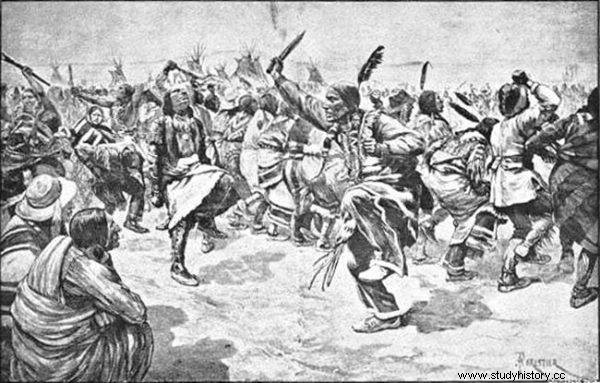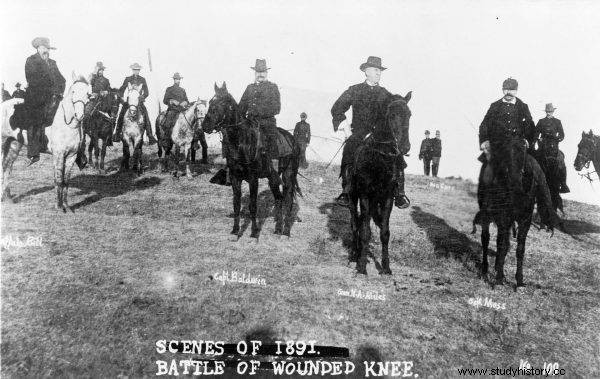This was the last major military clash between the United States Army and the Indians of the Great Plains. On December 29, 1890, the whites, concerned about the Spirit Dance religion and the commotion it caused on the reservations, killed over 150 Indians.
For much of the United States' westward expansion, there were attempts to seize plots belonging to its indigenous peoples. The Indians held up regular and increasing resistance to the invaders, which intensified in the second half of the nineteenth century as the federal government of the United States repeatedly signed and violated treaties with various tribal leaders of the plains.
The most prominent of these were the Sioux Indians, a subgroup of which is the Lakota. The Fort Laramie Treaty of 1868 established the Great Sioux Reserve of 60 million acres and created agencies to represent the federal government in each tribe. If the Lakota had stayed on the reservation and refrained from attacking the white settlers, they would have received food rations, education, and other state-funded benefits. However, US interest in the reserve's natural resources resulted in a series of conflicts that saw the Great Sioux Reserve shrink from 60 million acres to 21.7 million acres by 1877.
The unbroken stretch of land now consisted of six separate reservations centered around existing federal agencies. Political conflicts with indigenous peoples led to increasing tension. How did the Indians live and why did they decide to face up to federal agents? You will learn about it in this article.
Difficult living conditions of the Indians
The recognition and allocation of the Indians' territories to the US government meant that they had to change their identity almost completely. Federal agents encouraged them to breed cattle and crops and a lifestyle that did not fit the semi-arid environment of the northern Great Plains and was largely alien to the nomadic game-hunting people. The Lakota had to adopt Western dress, learn English, follow Christian principles and abandon traditional religion. This process of forced assimilation destroyed the Lakota culture and identity. Additionally, the government's rationing program made the escape from the reserve impractical. Without access to their large hunting grounds, the Lakota were forced to rely on government rations to survive. In 1889, the US Congress cut the annual budget for Lakota food rations. Combined with the harsh winters and droughts of 1889-1890, the tribe was pushed to the brink of famine. Food problems, government pressures, and drought led to a renewal of the Spirit Dance religious movement.

An 1891 print of the Ghost Dance at Wounded Knee
The Ghost Dance was not a new move:the first iteration was around 1870 among Nevada's North Paiute. The real renaissance of faith took place in 1889 under the leadership of the prophet Wovok from the Paiute tribe. During a total solar eclipse on January 1, 1889, Wovoka lost consciousness and experienced a dream that he believed was prophetic. According to his millennial interpretation, God told him that the Indians must remain calm and perform the ritual circle dance on a regular basis. Had they followed these instructions, God would have returned the earth to its natural state prior to the arrival of European colonists in 1891.
For many of the Plains Indians, this was a tempting promise. The Lakota modified the Spirit's Dance to respond to the intense violence they experienced at the hands of white settlers and the US military. They began to wear white "ghost shirts" painted with various symbols which they believed would protect them from bullets.
Destruction of the religious movement
In August 1890, Daniel F. Royer became head of the Pine Ridge agency. While some federal agents and officials were more tolerant of Ghost Dance practice, Royer was convinced that the Indians had become too militant and that their actions could destroy decades of US government efforts to "civilize" the Lakots. When the Bureau of Indian Affairs (BIA) called for a list of "conflict" Indians, Royer put most of the influential members of the Dance of the Spirit at the top of his list and demanded that the military take care of the case.

In November, the US military entered the Lakota Reservations to contain the growth of the religious movement.
In November, the U.S. military entered the Lakota Reserves to contain the rise of the religious movement. One source indicates that this was the largest federal troop deployment since the end of the Civil War in 1865. The greatest local enemy to the US government was the mighty chieftain Sitting Bull. As a spiritual leader, he led the Lakota and North Cheyenne to victory in 1876 against the American army at Little BigHorn. Although he was not a practicing member of the Ghost Dance, his legend, influence and official resistance to the government led to his elimination. Major James McLaughlin decided to arrest Sitting Bull for his role in making religion possible.
On December 15, McLaughlin dispatched 43 tribal policemen to Seated Bull's cabin. The chief obeyed, but his followers had no intention of giving up their ruler without a fight. A fierce fight ensued and possibly nine Hunkpaps were killed. As it turned out later - Sitting Bull was among the dead.
Death of the Sitting Bull and exacerbation of the conflict
The killing of the Sitting Bull caused fear in the hearts of those Lakota who opposed life on the reservations. Thousands of Indians gathered in the South Dakota Badlands in preparation for an attack on their government oppressors. Others traveled to Pine Ridge, where the Oglali tribe chief - Red Cloud - tried to negotiate the preservation of the Lakota traditions without bloodshed.

Bigfoot, leader of the Sioux captured at the Battle of Wounded Knee, S.D. " In the photo, he lies frozen on a snow-covered battlefield.
Sitanka, the leader of the Miniconjou tribe, known to white Americans as Bigfoot, hoped to join those of Pine Ridge and help find a peaceful solution to the conflict. He was considered a person to threaten the US order and Miles ordered a 7th Cavalry squad to intercept Bigfoot, confiscate all weapons from his gang, and escort them to a military prison in Fort Omaha, Nebraska.
Outbreak of the massacre
On December 28, 1890, the 7th Cavalry Regiment, led by Colonel James W. Forsyth, arrived at Miniconjou Camp near Wounded Knee Creek, approximately 20 miles northeast of the Pine Ridge Agency. Sasquatchanakwa saw Forsyth's scouts and informed them that he would surrender without resistance. A day later, Forsyth gathered with Miniconjou to begin the gun confiscation process. The Indians were led to a nearby clearing, gathered in a circle, and surrounded by federal troops.

Sitting Taurus in 1882
Forsyth made it clear:Miniconjou must surrender all his weapons. Sasquatchanakwa hesitated, but surrendered a few weapons as a sign of peace. Forsyth was not satisfied with this and ordered a thorough search of the people and their camp, where a lot of war equipment was found. The insistent search angered part of the Miniconjou tribe. One of the Indians decided to start the Dance of the Spirit while calling other tribesmen to attend the ceremony. He argued that they were to wear holy shirts as they would protect everyone from bullets.
The climax was when one of the soldiers demanded the hand over of a deaf tribe member. He refused to obey the order, and the weapon accidentally fired. At this point, all cavalry opened fire. The members of the tribe had nothing to defend themselves with, because they had given up their guns moments earlier. Within a short time, dozens of Miniconjou were shot. Bigfoot was also among those killed. Some women and children tried to flee the scene and sought protection in a nearby gorge. Unfortunately, the previously deployed cannons of federal soldiers fired on innocent people with a burst of fifty rounds per minute. The Indians who fled the rifle range were chased on horseback and then murdered.
Consequence of the massacre
The Wounded Knee Massacre was the last great armed conflict between the United States and the Plains Indians. The Spirit Dance religion had died out, and Wovoka himself begged his people to follow "the only path open now - the way of the white man." It should be recalled that in February 1973 some 200 American Indian Movement activists occupied the village of Wounded Knee to warn the public of continued civil rights violations on the Pine Ridge Reservation. The Indians proclaimed him the "Independent Oglala Sioux Nation" and refused to leave until the US federal government:removed the chairman of the Sioux, made a declaration honoring all Indian treaties, did not improve treatment of Indians nationwide.

Burying the dead after the Wounded Knee massacre. American soldiers lay the Indians in the common grave
Federal troops besieged the area for 71 days. Despite the hundreds of arrests that have occurred, activists have achieved their goal of drawing attention to the repeated violations by the United States of the rights and sovereignty of American Indians.
